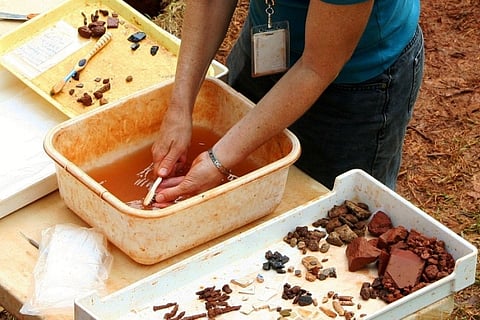

Over 3,770m years ago, the Earth looked very different. There were no plants, no animals, the sky was not blue. The surface would have resembled a bare rocky wasteland.
Yet it was around this time that we think the first life appeared, deep in the ocean around hot fissures in the seabed known as hydrothermal vents. Here, hot fluids circulate through the rocks on the seafloor, carrying iron and other elements out of the rocks and into the surrounding water. The chemicals and energy in these environments make them look like the perfect place for life to start.
To test this theory, my colleagues and I studied an ancient group of rocks in north-east Canada called the Nuvvuagittuq belt, dated to be between 4,280m and 3,770m years old. Preserved within this belt are iron formations formed in settings analogous to hydrothermal vents today. And in it we found microfossils that we believe to be 300m years older than the previous oldest known microfossils from rocks in western Australia dated to be around 3,500m years old. That makes these the oldest known fossils and possibly the oldest known evidence for life on Earth.
Rocks created from hydrothermal vent precipitates on the seafloor. Dominic Papineau
To uncover the fossils, we cut slices of the rocks so thin you could see through them and study them with a microscope. In doing so, we found microscopic filaments and tubes of iron, ranging in size from 5-10 microns in diameter, less than half the width of human hair, and up to half a millimetre in length. The tubes and filaments we saw were very detailed features that shared remarkable similarities with fossils of microbes in younger rocks and also modern microbes.
Features of these ancient filaments, such as their attachment to clumps of iron, are similar to those found in modern microbes, which use these clumps to hold themselves to rocks. These iron-oxidising microbes trap iron coming out of underwater vents, which they use in a reaction to release chemical energy. They then use this energy to turn carbon dioxide from the surrounding water into organic matter, allowing them to grow.
Filament microfossils. Matthew Dodd
When we found the fossil structures we knew they were very interesting and promising candidates for microfossils. But we needed to demonstrate that this is what they really were and that they weren’t a non-biological phenomena. So we assessed all the likely scenarios that could have formed the tubes and filaments, including chemical gradients in iron-rich gels and metamorphic stretching of the rocks. None of the mechanisms fitted with the observations we had made.
We then looked for chemical traces in the rocks that might have been left behind by microorganisms. We found organic matter preserved as graphite in a way that suggested it had been formed by microbes. We also found key minerals that are commonly produced by the decay of biological materials in sediments, such as carbonate and apatite (which contains phosphorus). These minerals also occurred in granule structures that commonly form in sediments around decaying organisms and sometimes preserve microfossil structures within them. All of these independent observations provided strong evidence for the micro structures’ biological origin.
Filaments attached to a clump of iron. Matthew Dodd
Together, this evidence very clearly demonstrates a strong biological presence in the 3,770m- to 4,280m-year-old rocks, pushing back the date of the earliest known microfossils by 300m years. To put that timescale into perspective, if we went back in time 300m years from today, the dinosaurs would not yet have even come into existence.
The fact we found these lifeforms in hydrothermal vent deposits from so early in Earth’s history supports the long-standing theory that life arose in these types of environments. The environment that we found these ancient microfossils in, and their similarity to younger fossilised and modern bacteria, suggests that their iron-based metabolisms were among the first ways life sustained itself on Earth.
Quartz crystal with nanoscopic inclusions that may have formed from organic matter. Matthew Dodd
It’s also worth remembering that this discovery shows us life managed to take hold and rapidly evolve on Earth at a time when Mars had liquid water on its surface. This leaves us with the exciting possibility that if the conditions on the Martian surface and Earth were similar, life should also have begun on Mars over 3,770m years ago. Or else the Earth may have just been a special exception.
Matthew Dodd, PhD candidate, UCL
This article was originally published on The Conversation. Read the original article.